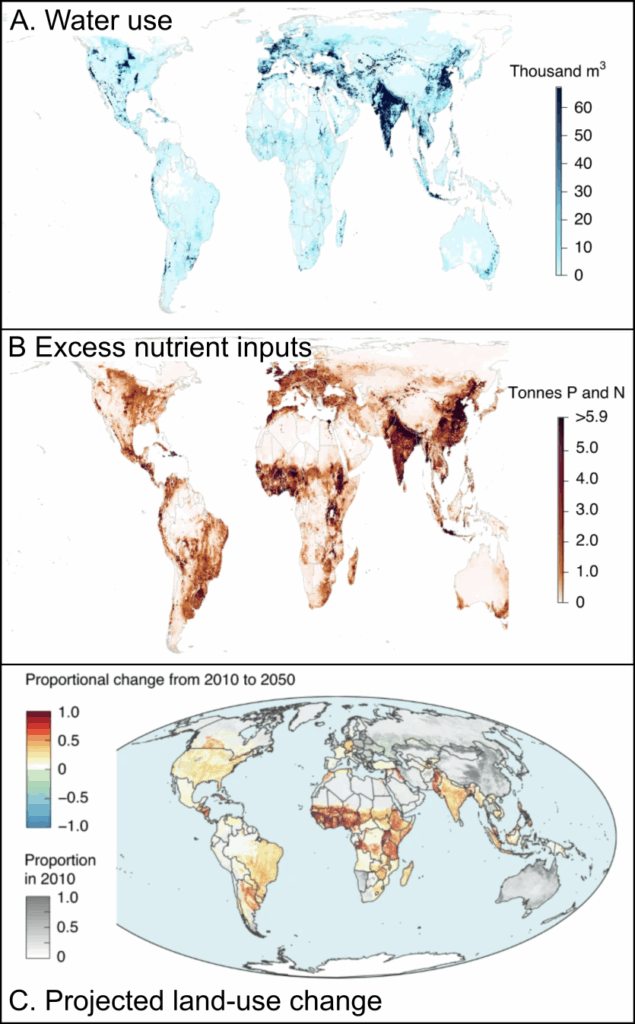Plenty more fish in the river? Projecting future threats to global freshwater biodiversity
Globally, freshwaters are home to 30% of the world’s vertebrate species and freshwater fisheries support millions of people by providing vital nutrients and protein to some of the world’s poorest communities. However, freshwaters are both severely threatened (80% biodiversity decline since 1960) and chronically under-studied. A combination of pollution, invasive species, overfishing, aquaculture, and climate change are driving thousands of species to extinction, risking both the loss of a large proportion of global biodiversity, and human wellbeing.
Understanding how and where threats to freshwaters are likely to be most threatened in the future is therefore a priority for biodiversity conservation and protecting crucial ecosystem services. If we can identify the regions most likely to be under pressure from different threats, then decision makers can proactively put measures in place to alleviate those pressures and safeguard freshwater biodiversity and the benefits it brings.
In this interdisciplinary project, you will do just that: combining a range of data sources and techniques to understand how and where threats to freshwater biodiversity are likely to develop, and what can be done to reduce them. This has the potential to produce high impact, highly influential research to help guide action at a range of spatial scales.
First, you will build an understanding of where threats to freshwaters are likely to increase in the future. You will combine projections of agricultural, aquacultural, and urban expansion (e.g. Gao & Pesaresi 2021; Williams et al 2021) and climate change (e.g. CMIP6) with estimates of how such expansion affects water use and nutrient pollution (Halpern et al 2022). This will allow you to identify where future pressures on global freshwaters are likely to be greatest.

Next, you will estimate where such pressures will have the greatest impacts. You will combine global maps of biodiversity (e.g. Collen et al 2013; Miqueleiz et al 2025) with long term biodiversity datasets and innovative trait based analyses to estimate the sensitivity of different regions to these pressures and pinpoint high risk groups.

You will then have a lot of freedom within the project to focus on whatever interests you the most. For example, you could investigate the probable impacts of changes on ecosystem structure; you could explore trade-offs between different development goals and biodiversity (e.g. how does agricultural intensification to support human nutrition affect freshwater biodiversity nearby?) or between different elements of development (e.g. nutrition from freshwater aquaculture vs. nutrition from wild caught fish); or you could focus on which conservation and sustainability approaches are likely to be most successful (e.g. protected areas compared to changes in consumption).
Throughout the project you will develop a range of interdisciplinary skills. A strong grounding in quantitative methods is essential, and you will be able to build on this to develop expertise in (for example):
- Data science and spatial modelling;
- Ecological trophic structures and their response to environmental change;
- Links between freshwater ecosystems and human health and nutrition;
- Climate change and freshwater biodiversity;
- Agricultural expansion and freshwater environments;
- How economics and demographics drive broad environmental change.
Due to the challenges surrounding effectively sampling freshwater biodiversity, particularly in remote and dangerous biodiversity hotspots, a key focus of this project will be to incorporate an assessment of uncertainty in the datasets used. This will be imperative for communicating results with stakeholders such as the IUCN, Shoal, and national and regional biodiversity managers.
In combination, the skillset developed during this project will provide you with an ideal footing for a career in or outside of academia.
